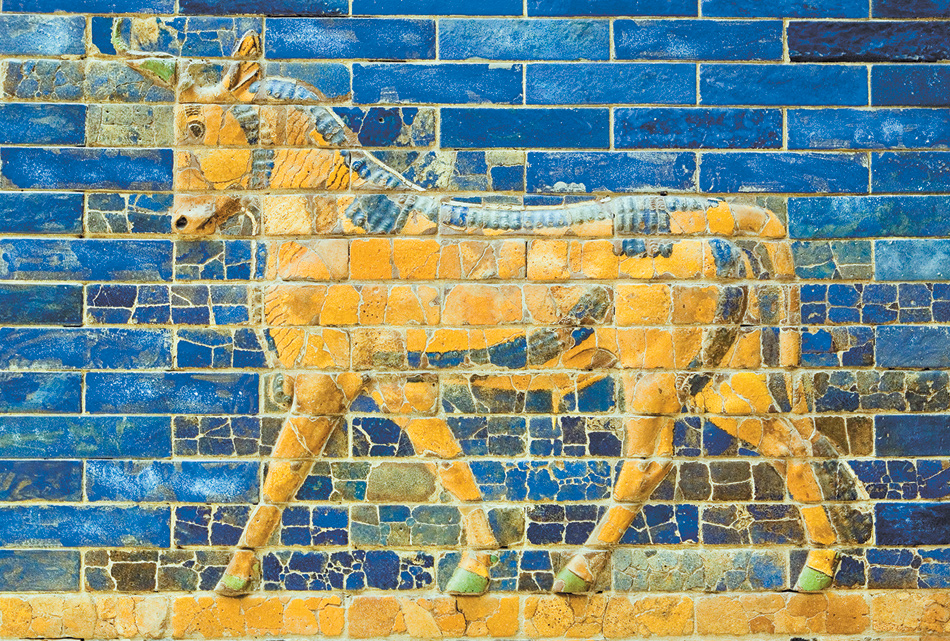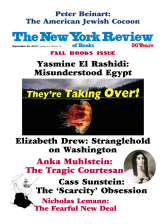In response to:
The Coming Death of Venice? from the June 20, 2013 issue

Museum Island, Berlin/Massimo Ripani/Grand Tour/Corbis
Detail of a reconstruction of the sixth-century-BC Ishtar Gate of Babylon, at the Pergamon Museum in Berlin. For more on Babylon, Nineveh, and the Hanging Gardens, see the article by Timothy Potts in this issue.
To the Editors:
As the mayor of Venice—puzzlingly dismissed by Anna Somers Cocks as “just a lawyer”—I write in response to her article “The Coming Death of Venice?” [NYR, June 20].
Venice has been a World Heritage Site since 1987. The Italian government decided to make the requirement for a UNESCO site management plan compulsory in 2006. Hence the plan recently adopted by the city after very thorough preparatory work. The UNESCO site plan is not prescriptive in a binding way (unlike the PAT, Piano Assetto Territoriale, which is a legally binding instrument adopted by the City Council), and sets out the range of problems concerning the management of Venice and its lagoon as a World Heritage Site. In many ways the UNESCO plan could be viewed as a sort of catalogue raisonné on which to implement policy options.
Its preparation has brought together, for the first time, all the authorities comuni—provincial governments, central government and regional bodies, business associations and trade unions, civil society, etc.—responsible for the management of Venice and its lagoon. Anyone with even a scant knowledge of the vagaries of local government coordination in Italy will understand this is a success that will prove its mettle as time goes by. Is all this too little, too late, as Ms. Somers Cocks states? It is of course a matter of judgment, but it would be a good idea not to lose track of what this UNESCO-based document is about.
The large ships must stop coming through St. Marks and the Giudecca Canal. No matter how remote the danger of an actual accident may be, the risk should not be run. I have stated my position on many occasions, but while the mayor of Venice rules over the canals in the city, he has no authority over the main transit canals, which fall under the responsibility of the central government. I hope that all the friends of Venice will join me in urging the government to put an end to this situation, before anything untoward happens.
The cruise traffic provides significant benefits to the city and the ships should be allowed to reach Venice, through a different route. Many alternative possibilities are being discussed: shifting the passenger terminal to Marghera (my preferred solution), creating a new offshore port, dredging some of the existing canals. Time is of the essence, however: we need to get the ships out of St. Mark’s, and to do it fast. For this I can only say: Help me!
Tourism is vital to the well-being of Venice. According to the World Trade Organization, by 2020 the relative importance of Europe as the primary tourist destination will decrease: crowds will continue to come, but the biblical scourge anticipated by Ms. Somers Cocks may turn out to be more manageable than she seems to anticipate. The situation is closely monitored by the local institutions, and progress is constantly being made. I strongly disagree, on the other hand, with Ms. Somers Cocks’s ideas on limiting numbers, timed admission tickets, and so on. She compares Venice to MoMA to press her point and the comparison is illuminating: MoMA is a great museum, but Venice is not and never will be, for as far as I will be able to muster authority, anything approaching a museum. Such an idea is dear to some of our foreign friends, but it is fundamentally flawed and wrong.
From John Ruskin to Thomas Mann, from André Maurois all the way down to Donna Leon, over the centuries the seduction of this city built around, in, and because of water has proved irresistible. Its liquid beauty often defies rational thought, so much so that any kind of life other than one germane to the romantic dream appears irrelevant. Such as the lives of the Venetians themselves, at times characterized as unworthy of the privilege of living in the city bestowed on them (and, incidentally, built by them). Venice is all of this but is, first and foremost, the capital of one of Italy and Europe’s most vibrant regions. It is this Venice that needs to become once again a hub of activity without which its beauty will inevitably fade: the magic of place can flourish around real life, not in its stead. The support of international public opinion in achieving this goal would be the best gift Venice could receive from its foreign friends. I will never accept for my city the fate of another “colonial Williamsburg” beautifully preserved in cultural formaldehyde.
Ms. Somers Cocks loves Venice passionately, while passably tolerating its inhabitants. She agonizes over the “politicized wrangling” on the city’s fate: understanding the ways of political life in Italy can be a tricky subject for Italians surely, and more so for our foreign friends. Our democracies are the expression of advanced societies, at the forefront of social and economic development. Neither is perfect but they represent the collective will of their peoples, and should be viewed in this context. Both are happy to entertain discussion and reasoned criticism; both are loath to sermonizing.
Advertisement
Giorgio Orsoni
Mayor of Venice
P.S. A longer response to Ms. Somers Cocks’s article is posted on the City of Venice website: www.comune.venezia.it.
Anna Somers Cocks replies:
Mayor Orsoni pretends not to understand when I contrast the background of Paolo Costa, head of the Venice Port Authority, who has been minister of public works and president of the EU Parliament’s Committee on Transport and Tourism, with the mayor’s background as a lawyer. The law is an estimable profession but it is clearly Costa who has accumulated the greater patronage and political power, and it is Costa who wants the huge cruise ships to continue docking in Venice.
I am glad the mayor states unequivocally here that the ships must stop sailing through Venice. What puzzles me is that the management plan for the city produced only a few months ago by his own administration and signed off on by him is silent on this issue. I hope that my “sermonizing” (as the mayor calls it) in this journal, republished by La Repubblica newspaper and Il Giornale dell’Architettura in Italy, has helped focus the general indignation at these monster intrusions and nudge the central government into convoking the meeting that took place in Rome on July 25 to discuss solutions to the problem.
After the meeting in Rome, the minister for infrastructure, Maurizio Lupi, said that by the end of October the Magistrato alle Acque (the state body responsible for the lagoon) and the Capitaneria di Porto of Venice, run by the navy, will have examined the alternatives to the ships coming through Venice. They will report to Lupi and the minister for the environment, Andrea Orlando, who will make their choice after a meeting of the Comitatone (literally, the very big committee), a body set up to vote on special funding for Venice, composed of the prime minister, various members of the cabinet, crucially, the minister of finance, the mayor of Venice, and other leaders of local government. It looks as though there really might be some progress.
So far as the tourists are concerned, it is disappointing to read the old cliché repeated that to limit their numbers by ticketing would turn Venice into a museum. What is already turning Venice into a very disagreeable, badly presented sort of museum is the failure to manage tourist numbers, which is driving out the Venetians and killing off all but the tourist economy.
Last, but very much not least, it is deeply worrying that Mayor Orsoni does not even mention the lethal threat to the city from sea level rise, another issue that is ignored in the management plan. Is it possible that he is unaware of mid-August’s draft report of the Intergovernmental Panel on Climate Change, which predicts that seas will rise between 29 and 82 cm (11.4 to 32.3 inches) by the end of this century, which is above the 2007 estimates of 18 to 59 cm? Is he unaware of the damage the chronically raised water levels have already done to the fabric of the city?
Italy, as the Italians are the first to tell you, has had years of weak central government blinkered by short-term concerns; it has a crisis in the economy and in public funding that has hamstrung Mayor Orsoni in his job as the custodian of this extraordinary and fragile city. And then there is corruption. In July, the head of the powerful Consorzio Venezia Nuova and six other members of this association of firms building the €7 billion mobile flood barriers were arrested as part of investigations into the alleged rigging of contracts and fraudulent invoicing on a very large scale.
In the midst of all this, the least that Orsoni’s administration could do is draw up a management plan that laid out the city’s most obvious problems clearly and fearlessly. This it has not done, yet without realism there can be no remedy.
This Issue
September 26, 2013
The American Jewish Cocoon
They’re Taking Over!
Stranglehold on Washington



